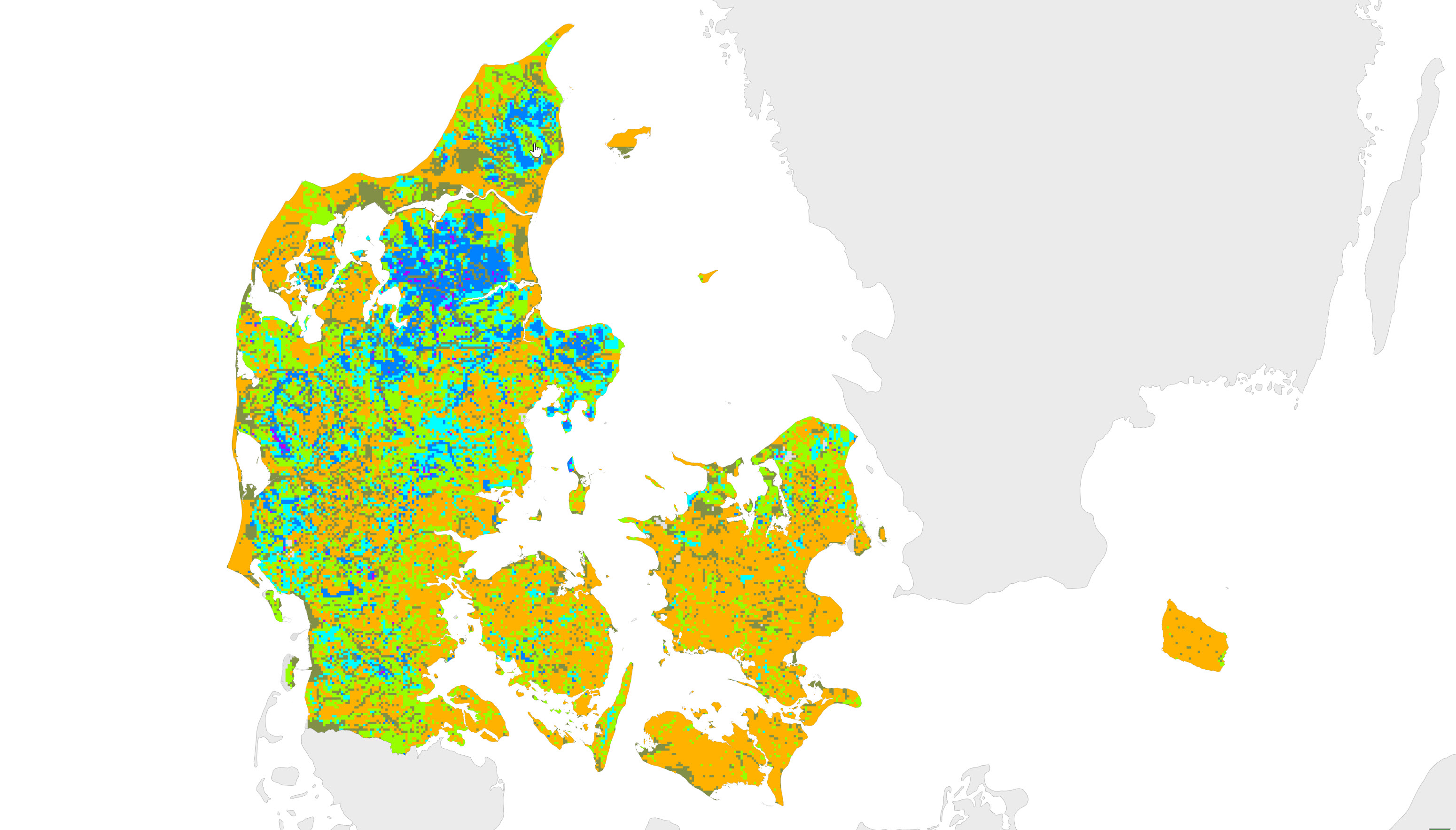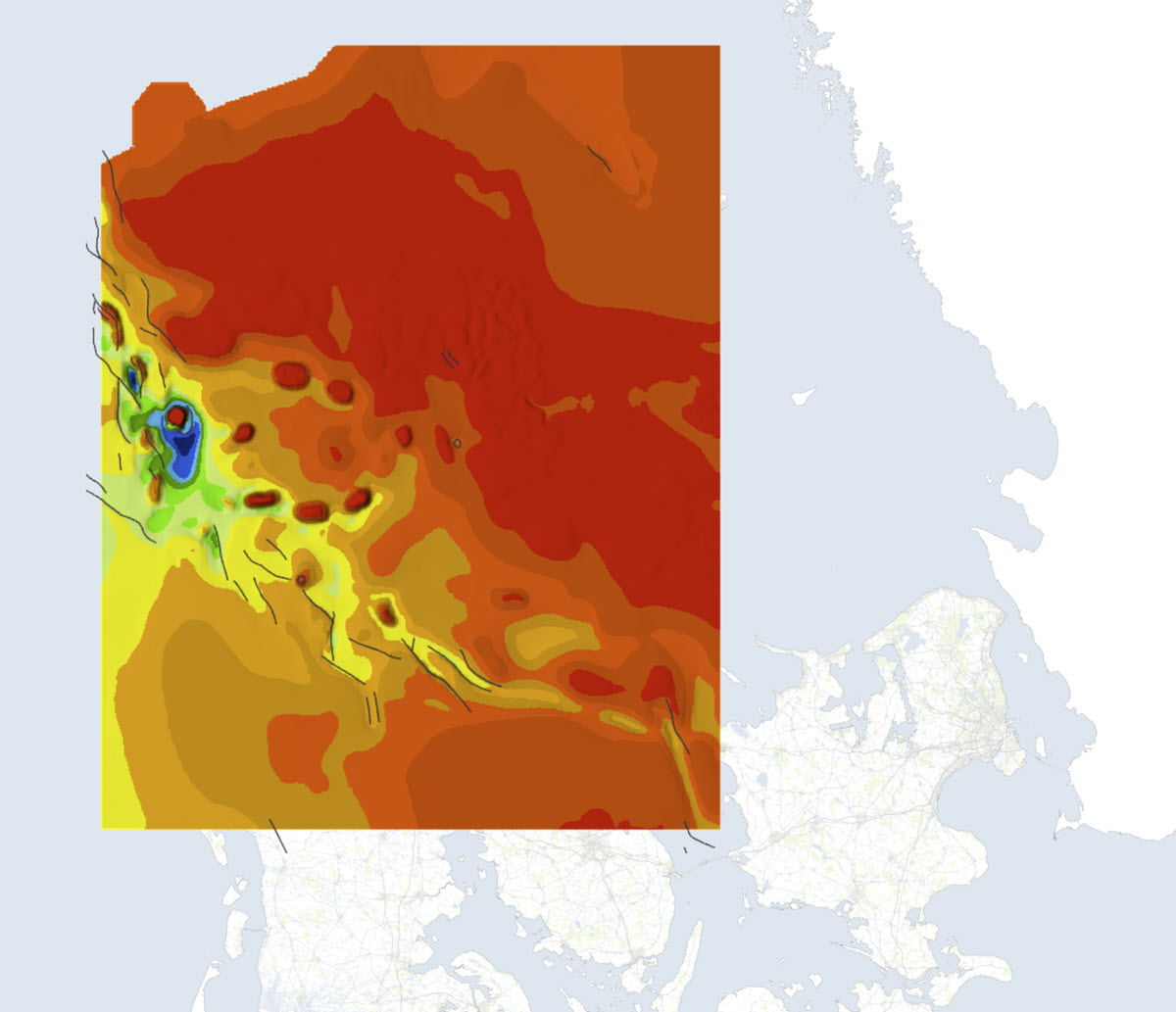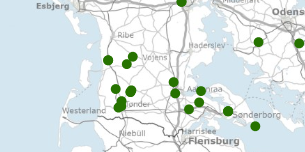Type of resources
Available actions
Topics
Keywords
Contact for the resource
Provided by
Years
Formats
Representation types
Update frequencies
status
Scale
Resolution
-

This map is the first national map showing the depth in meters to the uppermost redox interface in sediments of Quaternary age. The redox interface indicates the transition from the oxidized to the reduced geochemical environment in sediments. The redox interface was identified according to the colors of the sediments in 11,999 wells and is shown for 1x1 km grid-cells. For grid-cells with multiple site information, the depth to the redox interface is indicated by an average value. For grid-cells without any field information, the depth of the redox interface was established based on information about 1) geological setting, 2) morphology, 3) depths to redox boundaries at nearby field sites, 4) GEUS surface geology map, 5) topography, and 6) the pre-quaternary surface. The method for this first national redox-map and the data used is described in GEUS report no. 93 (2006) entitled Beregning af nitrat-reduktionsfaktorer for zonen mellem rodzonen og frem til vandløbet. Data og metode for 1.generationskortet (in Danish). The Redox map is also described in Vand og Jord (2011) 18: 37-39 (in Danish).
-

The map is based on selected seismic data up to 2001. The map shows the structural conditions at depth for the 'Top Kalk' surface, from the central to the eastern part of the Danish North Sea. 'Top Kalk' denotes the surface which forms the basis of the Tertiary deposits (except Denmark). The map is described in GEUS Bulletin No. 13. 2007.
-

The Samba database among other things contains information about deep wells in the Danish sector, acquired according to the Danish Act on the Use of the Subsoil. That is: exploration, appraisal, delimitation and production wells related to oil/gas. Also wells with other purposes such as: geothermal energy, gas storage, salt production and scientific research. The data sets contains technical, administrative and geological information about the well and about the geophysical measurements undertaken in the well (well logs and reports). Data are submitted by the company to whom the permission has been granted. The database is updated on an ongoing basis.
-

Historical mineral exploration and exploitation licences in Greenland. The data are converted from the WFS that the ministery of mineral resources (MMR) in Greenland provides. Links are provided in the online resources.
-

Dataset containing a summary of geological information for known mineral occurrences on Greenland. The information includes the location, size, mineral commodities, mineralisation type, exploration history and a geological description of the deposit. The data has been collected and compiled from fieldwork investigations conducted by geological surveys, academic researchers and mineral exploration companies.
-

The regional-scale gamma spectrometry data are associated with two collaboration projects involving the Geological Survey of Greenland (GGU) and the Danish Atomic Energy Commission’s Research Establishment. The projects' objectives were to outline areas with an elevated uranium potential in two regions of Greenland: The airborne radiometric surveys in southern and central West Greenland in 1975/76 and the SYDURAN project in South Greenland in 1979-1982. To acquire the data, four-channel gamma ray spectrometers were mounted upon an aircraft (1975/76 surveys) and a helicopter (SYDURAN project). The vehicles flew along shoreline and valley contour lines at low average terrain clearances of 100 and 50 m respectively. The data were recorded without GPS systems, and so positioning was estimated when known landmarks were passed. This means that the dataset is sparse and inhomogeneous, and the spatial accuracy remains low. The gamma-spectrometer had been calibrated at a pad facility at Risø, which enabled the conversion of recorded counts per second into simulated concentrations of radioactive components in the surface of the overflown terrain. Large parts of the data (surveys from 1975/76) were originally stored on magnetic tapes and data were transferred to datafiles in 2003 to make them digital accessible. Most data were retrieved and are now available as ASCII files.
-

Dataset containing standard polygons for regions of Greenland and specific hand-drawn polygons representing the areas where the study was conducted that is described in the publication. Data can be filtered for publication title, authors, year of publication and the list of attributes contains other reference information including a link to the publication. The publications include GEUS Bulletin (2020 - ), Geological Survey of Denmark and Greenland Bulletin (2004 - 2019), Geology of Greenland Survey Bulletin (1997 - 2002), Bulletin Grønlands Geologiske Undersøgelse (1948 – 1996) , Danmarks og Grønlands Geologiske Undersøgelse Rapport, Rapport Grønlands Geologiske Undersøgelse (1964 – 1996), Open File Series Grønlands Geologiske Undersøgelse, Mima rapport, Grønlands Geologiske Undersøgelse Geological Map Descriptions and Geological Survey of Denmark and Greenland Map Series.
-

The Geological Survey of Denmark and Greenland has previously conducted sampling campaigns of heavy mineral concentrate in Greenland. The sampling methods are described according to their sampling years below. Unfortunately, not all the samples have reported as the campaigns in have not been undertaken on regional scale and therefore fallen under smaller projects or sampled under projects that have had other objects, and not all elements were considered relevant in the reports, translating to that metadata concerning the analyses are missing. All together there are geochemical analyses of 725 heavy mineral concentrate samples. The samples that are mentioned in reports below, are 319 in number, and do not comprise all heavy minerals samples collected the specified years. Samples collected in un-mentioned campaigns do occur in the full list. Use of data that is not mentioned here, needs caution and the quality should be weighed against other data. Years 1982-1986 A regional sampling campaign was conducted between 1982 and 1986, these samples are described in Appel 1989. These samples comprise the analysis batch numbers 10, 36 and 55. Numbers 10, 36 are analysed at Activation Laboratories and 55 analysed at Bondar-Clegg and Co. Ltd., both in Canada. In this campaign 210 samples were collected and are all sampled in the area around Nuuk. Sampling procedure: In the field: The coastal areas were accessed by boat while inland areas were accessed by helicopter. Four litres of coarse gravel and sand were collected and sieved through a 6 mesh of brass. The fines (c. 10 %) was panned and inspected in ultraviolet light and the scheelite grains counted. In the laboratory: The samples were dried and separated by bromoform, the heavy material was weighed and the scheelite grains counted again. A small splitter separated c. 0.5 gram of each sample for analysis of W, Mo, Pb, Cu, Cr, Co, V, Mn, Zr, Ni and Fe. During the years the sampling programme as well as the analysis methods changed. In 1983 the four litres were added up to five. In 1985 the material increased to 5-6 litres (or 10 kg). In 1986 a plastic sieve with 1 mm holes used and filled three times (5-8 kg) for each sample, the volume of fines was measured. C. 10 gram of each sample was analysed by Bondar-Clegg for (Sc, Cr, Fe, Co, Ni, As, Se, Rb, Mo, Ag, Cd, Sb, CS, BA, La, Eu, Tb, Yb, Hf, Ta, W, Ir, Au, Th and U) analyses. The reader should note that the analyses below detection limit is given as "0" (zero) and not analysed as "-1" for the samples collected in this campaign (year 1982-1986, i.e. batch numbers 10, 35 and 55). Year 1991 In 1991, 106 streams were sampled for heavy mineral concentrate, in the southern part of the Nuuk area, between 62°30?N and 64°N. Sample procedure was as follows: 5-10 litres of detrital material, < 5 cm, were collected, from 2-5 sub-localities in the stream bed. Wet sieving split the sample in less-than and bigger-than 0.5 mm, and the coarser fraction inspected for economic minerals. The fine fraction was heavy minerals concentrate was produced using a rotary panning device "goldhound" (see Erfurt et al., 1992 for reference). The heavy mineral concentrate was shipped to Denmark and dried and further spilt for analytical purposes. Activation Laboratories, Canada, analysed the samples for 35 elements including gold, with INAA and ICP-ES. Analyses batches are numbered 10 and 36. Unique samples number 103 for these two batches. In additional batch 41, has analysed Pb, Cu, Ni and Zn. Year 2004 The analyses batch no. 193 and 194 have been described in GEUS report 2004/42, and were sampled in 2003 in the Qaanaaq region in North-West Greenland. Six samples were collected in this campaign and sieving of 1.0 mm material on site and a pre-concentrate by panning of the fine fraction. In Copenhagen minerals with > 2.8 g/cm3 density was produced by heavy liquid separation. The rest The remaining 406 samples (analyses batch numbers: 10, 15, 21, 35, 36, 41, 55, 165, 166, 193, 194, 374, 375, 376, 1014, 1015, 1016, 1017, 1029, 1030, 1051, 1052, 1077 and 1078) have been analysed in addition to the laboratories mentioned above, at Risø National Laboratory in Denmark. As reports have not been available for writing up these analyses, the description is limited to the analyses. Chances are, however, that sampling procedures are similar to the descriptions above. The analyses below detection limits of the remaining 406 unique samples have not been consistent, but are presented as "0" or as negative values and elements that have not been measured as "0" or empty cells.
-

GEUS' Earthquake Portal provides information on all recorded earthquakes in Greenland. The data are extracted from GEUS' earthquake database and are updated daily. As a result, the timing, locations, and magnitudes of events may change as new data are added and existing events are revised. Continuous quality control is carried out, aiming to identify and remove explosions – typically related to military exercises or the removal of old munitions. Therefore, the list may change over time, and some uncertainty may be associated with the determination of epicentres and depths. The portal displays information for each earthquake, including the time of occurrence (year, month, day, hour, minute, second) in Greenwich Mean Time (GMT), the geographical location and depth of the epicentre, and the local magnitude measured on the Richter scale. Earthquake data can be exported from the portal according to the defined zoom level and map extent.
-

The area in South-East Greenland between 62°30’N and 66°30’N was targeted for its mineralisation potential through data collection and renewed mapping during the collaborative ‘SEGMENT’ project (2009-2014) between the Geological Survey of Denmark and Greenland (GEUS) and the Bureau of Minerals and Petroleum (BMP, now Ministry of Mineral Resources, MMR). The main aims of the ‘SEGMENT’ project included: • Compiling a regional stream sediment geochemical and till indicator mineral survey; • Compiling a regional aeromagnetic survey of South-East Greenland; • Conduct geological field investigations in order to characterise the main lithology and as the basis for geological research, including petrology, structural geology, geochemistry and geochronology; • Evaluate economic geology and mineral potential through field investigations, using geological parameter in order to be able to predict possible mineralisation; • Revise the existing 1:500 000 geological map of South-East Greenland; and • Integrated data interpretation to describe and provide a geological model for the geological evolution of South-East Greenland and assess the mineral of potential of the region. The details behind the data collection and mapping efforts under the ‘SEGMENT’ project are summarized in the GEUS report by Kolb et al. (2016) which provides an overview of the geology and the lithological units within the mapping area between 62°N and 66°30’N.
 Geus Geonetworks metadata catalogue
Geus Geonetworks metadata catalogue